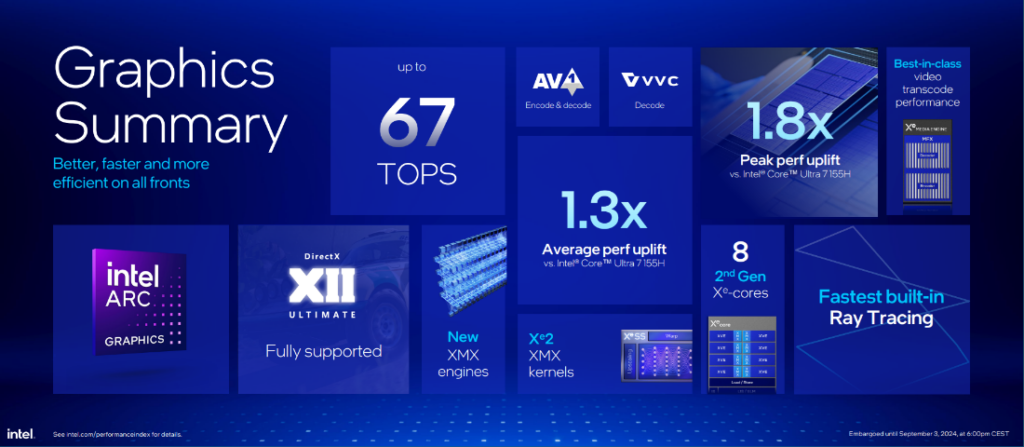Intel’s Arc Graphics Xe2-LPG iGPU in the Lunar Lake CPU offers impressive specifications and test data, outperforming rivals in certain benchmarks while using 30% less power. Intel Senior VP Jim Johnson stated that Lunar Lake brings 1080p gaming to thin and light systems with great frame rates and frame times. The company’s focus on edge computing and on-device AI applications could lead to a resurgence in the laptop industry.

Claiming to beat all its nearest rivals, Intel’s Arc Graphics Xe2-LPG iGPU in the new low-power Lunar Lake CPU is offering impressive specifications and in-house test data.
Echoing Intel’s stated results, while running at 1080p, the Xe2-LPG (running at greater than 30 fps) outperforms AMD’s HX 370 by 16%, Intel’s previous-generation Ultra 7 155H by 31%, and Qualcomm’s XIE-84-100 by 68%. Those results are based on tests Intel ran using an AMD Ryzen Al 9 HX 370 in an Asus Zenbook S 16, an Intel Core Ultra 9 288V in an Asus Zenbook S 14, and an Intel Core Ultra 7 155H in an Asus Zenbook 14, as well as a Qualcomm Snapdragon X Elite XlE-84-100 in a Samsung Galaxy Book4 Edge. To make the claims, Intel ran benchmarks on all those platforms using 50 games. A footnote to that is from Intel Senior VP Jim Johnson, who noted, “that was difficult to measure because 23 of the games didn’t run on Qualcomm’s processor.” In addition, and most impressive, Lunar Lake was using 30% less power against Qualcomm during the testing. Johnson added that Lunar Lake “brings 1080p gaming to thin and light systems with great frame rates and really nice frame times.”
So, serious gameplay on the run with thin and light, at 1080p has arrived. And judging from the Intel testing, Lunar Lake is the best at it, but other thin and light machines can manage some of the games too. This could be considered a threshold moment in the PC industry.
Intel created a pretty slide that summarizes the characteristics of the Lunar Lake SoC.

Intel also revealed that its Core Ultra 200V Lunar Lake will power gaming handhelds like MSI’s Claw 8 Al+.
The AI features may be of interest, but the graphics architecture is particularly noteworthy, as it is tailored for low-power systems operating at 17W, which could have a significant impact on devices that rely on efficient power consumption.
Adding to the excitement, Phoronix announced its Mesa 24.2.2 is out with the necessary Intel OpenGL/Gallium3D (Iris) and Vulkan (ANV) driver changes for enabling Battlemage discrete graphics and Lunar Lake integrated graphics out of the box without requiring any “force probe” overrides for enabling the support.
Intel needs a hit, maybe a few of them.
In recent years, Intel has struggled to maintain its position in the premium thin and light laptop market, facing stiff competition from Apple’s silicon, AMD’s Zen Strix Point CPUs, and Qualcomm’s Arm-based chipsets. However, Intel is not remaining passive. The company is making a strong move with its Lunar Lake processors, which are based on the x86 architecture. These processors are designed to compete directly with Arm, while also offering the advantage of compatibility with the x86 platform.
Manini Sharma, product marketing manager at Intel, stated that the debate between x86 and Arm is no longer relevant, as Lunar Lake CPUs have achieved comparable or equivalent performance to Qualcomm’s Arm chipsets in certain benchmarks.
Intel’s plans for CPUs, GPUs, and NPUs remain focused on edge computing and on-device AI applications. As still the dominant player in the laptop industry, Intel could see a resurgence, particularly as the AI landscape shifts towards smaller models. The company’s position in the market might strengthen within the next year as it continues to adapt to these emerging trends.
Generally speaking, the four vendors’ GPUs line up as shown in the following table.
| Company | Class |
| Nvidia | dGPU |
| AMD | dGPU |
| Intel | dGPU |
| Chinese | dGPU |
| AMD | iGPU |
| Intel | iGPU |
| Qualcomm | iGPU |
| Apple | iGPU |
Relative GPU performance of the leading PC vendors.
Apple and Qualcomm may switch places from time to time.
The result of today’s SoCs that use very little power are small enough to be put in really skinny, thin and light cases or are hybrids like Microsoft’s Surface, and run for 15-plus hours while driving an HD screen, is truly amazing. It squeezes the power users into the very top niche segments, and with the lower volumes, the price goes up exponentially. Just like automobiles.
